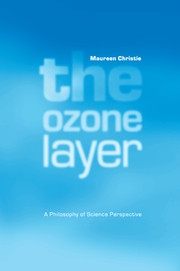Book contents
- Frontmatter
- Contents
- List of figures
- List of abbreviations
- Preface
- 1 Introduction
- Part I History of the understanding of stratospheric ozone
- 2 Stratospheric ozone before 1960
- 3 Chlorinated fluorocarbons
- 4 The Supersonic Transport (SST) debate
- 5 Molina and Rowland: chlorine enters the story
- 6 Too much of a good thing? Crucial data backlog in the Antarctic ozone hole discovery
- 7 Antarctic ozone hole – theories and investigations
- 8 Completing the picture: from AAOE to 1994
- Part II Philosophical issues arising from the history
- References
- Index
3 - Chlorinated fluorocarbons
Published online by Cambridge University Press: 22 September 2009
- Frontmatter
- Contents
- List of figures
- List of abbreviations
- Preface
- 1 Introduction
- Part I History of the understanding of stratospheric ozone
- 2 Stratospheric ozone before 1960
- 3 Chlorinated fluorocarbons
- 4 The Supersonic Transport (SST) debate
- 5 Molina and Rowland: chlorine enters the story
- 6 Too much of a good thing? Crucial data backlog in the Antarctic ozone hole discovery
- 7 Antarctic ozone hole – theories and investigations
- 8 Completing the picture: from AAOE to 1994
- Part II Philosophical issues arising from the history
- References
- Index
Summary
The most common form of refrigeration technology is based on the fact that when a liquid is forced to evaporate, it removes a large amount of heat from its immediate surroundings. The technology therefore relies on a gas which is fairly readily condensed by cooling or compression – a normal boiling point somewhere in the range from about 0°C to -50°C is preferred. Differences in other physical quantities then distinguish some such substances as good refrigerants or bad refrigerants.
But the physical properties are not the whole story. There are also chemical requirements. A substance cannot be used as a refrigerant unless it is chemically robust and stable. The refrigerant is cycled through a closed loop with two heat exchangers. In one it evaporates, and heat is removed from the interior of the refrigerator. In the other it is re-condensed by compression and the heat is emitted from the coolant loop into the room external to the refrigerator. There are moving parts that require lubrication, so the refrigerant must either itself have some lubricant properties, or be chemically compatible with separate lubricant substances that must be added. It is also desirable that a refrigerant does not constitute a toxic, corrosive, fire, or explosive hazard.
There are very few substances with boiling points in the range from -50°C to 0°C. The number of such substances that are chemically robust and were generally available during the 1920s was fewer than 10. All were either highly toxic, or highly flammable, or both.
- Type
- Chapter
- Information
- The Ozone LayerA Philosophy of Science Perspective, pp. 17 - 22Publisher: Cambridge University PressPrint publication year: 2001



